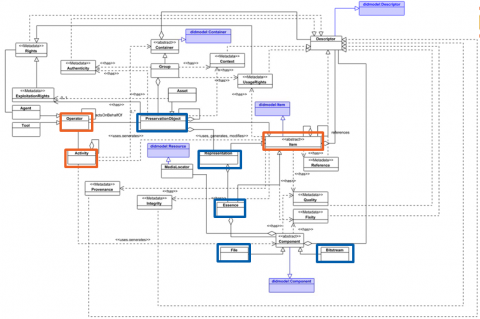
by Philip Merrill, January 2019
Audiovisual content and its metadata present certain challenges for preservationists and other curators, whether managing large archives or exchanging data with service providers. The issues of having sufficient metadata, consistently, for a library or archive, venture into filmic territory where identifiers and descriptors can be elaborate. Also, an archive engaged in an enterprise-level software upgrade might periodically need all its content stored in duplicate in memory, with complete institutional annotations included. MPEG Multimedia Preservation Application Format (MP-AF) supports an interoperably labeled system, designed to augment existing archive management systems.
Dublin Core, MPEG-7, MPEG-21, and European Broadcasting Union (EBU) Quality Control descriptors fit together in this MPEG-A integration. MPEG-7 descriptors were recently expanded to support MP-AF's need for video quality annotation. The payload of required metadata is in large part divided across eight sets of descriptors: provenance, context, reference, quality, fixity, integrity, authenticity, and rights.
Provenance lists chronological events when resources were made, modified, or changed their ownership or custody.
Context answers basic questions such as why and how a resource was created and it supports specification of how the many resources in a package relate to one another.
Reference stores unique and persistent identifiers and can link resources, either identical or related, across multiple repositories. The use of local identifiers is also supported, so different ID systems don't clash.
Quality assessment includes quantitative measurements as well as modification events that transformed a resource. MP-AF uses amended MPEG-7 multimedia description schemes that are compatible with the EBU's data model for quality control.
Fixity assures that the integrity of an original resource exists as intended and has not been altered, without documentation of the change. Temporally fine-grained checksums are supported.
Integrity is the state of the digital item as complete, containing the verified presence of unaltered/unmodified component-parts that are required. This can include relationships to Fixity and Component data. A set of identifiers and dependencies allows specification of a set of content items to be formally valid and unambiguous. Several validation checks are available.
Authenticity addresses the original form's existence in an untampered state by supporting metadata and data exchange expected to be compared between agents. In other words, MP-AF supports checking Authenticity but does not inherently guarantee that the preservation object is authentic. Therefore it has no specific descriptor but can include other related metadata.
Rights pertains to ownership, copyright, access and legal or contractual restrictions. Rights information is supported at different levels as needed. Usage rights are a low-level example where MPEG-21 Rights Expression Language support is adequate however MPEG-21 Contract Expression Language/Media Contract Ontology are available for higher-level support.
The MP-AF data model has abstract Operators, either Agents or Tools, that engage in Activities on Digital Items or Components. MP-AF uses MPEG-21 Digital Item Semantic Relationships to represent relationships between Digital Items. While the model takes advantage of MPEG-21 for its Digital Item framework and exploits MPEG-7 descriptors and extensibility, other aspects of its structure were designed for compatibility with systems already in use by the media industry, such as the European Broadcasting Union and Dublin Core. All Digital Items are combined into Preservation Objects.
Multimedia Preservation Description Information (MPDI) makes the Application Format a kind of super descriptor, like an umbrella or a mother-ship encompassing the set of smaller things needed. Whether high-level, regular or required, the package is designed to be interoperable with major data exchange formats as well as to provide an interoperable interface to the underlying media.
MP-AF provides interoperability as well as completeness in this package, and supports customization and additional descriptors. Recommended vocabularies are provided. MP-AF is designed with the understanding that some organizations will only need limited interoperability, for example with specific other organizations, and will appreciate the freedom to adjust the MP-AF framework for their own ease-of-use.
